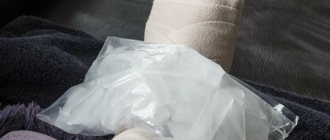Mechanical damage to a tooth due to injury without violating its integrity is called a bruise. This type of injury is common in children and adults, especially athletes. According to statistics, among all injuries to primary teeth, bruises account for 2.5%; bruises of permanent teeth account for 1.5% of the total number of traumatic injuries in the permanent dentition.
Even if the tooth looks unchanged after a bruise, it is necessary to visit a dentist to prevent the development of complications associated with the injury.
Symptoms
A strong blow to a tooth is accompanied by damage to periodontal tissue, and some fibers and small blood vessels rupture. There are no visible structural damage to the tooth; upon visual inspection, it appears intact. After a bruise, the tooth remains motionless, and minor mobility is rarely observed. The gums in the area of the injured tooth swell.
In the first hours after the impact, patients experience pain in the tooth, which intensifies when biting; the pain is aching in nature. The tooth feels high, and slight bleeding may occur from under the gum near it. When a bruise occurs, the neurovascular bundle of the tooth can be damaged, that is, the pulp is injured, and hemorrhage occurs in the pulp chamber, and the enamel becomes pink in color. A severe bruise can lead to the death of the pulp.
Often, when a bruise occurs, cracks appear on the tooth enamel, which can only be detected with a special examination.
Causes
There are many reasons for a tooth bruise. The most common is a strong direct blow to the jaw. Athletes often receive such injuries; they are almost always the consequences of accidents. It is impossible not to notice it, since after a blow the front tooth hurts, and the pain is usually sharp.
There is another reason - the so-called chronic jaw injury. The peculiarity of such injuries is that they are insignificant in their impact, but a person is constantly exposed to them. Examples include some human habits: biting nails, holding a pen or pencil in the mouth, cracking nuts, etc. Under the influence of such seemingly insignificant factors, the enamel becomes thinner and microchips form on it. The result of these innocent habits is tooth loss.
Injury can also occur during dental procedures performed by an inexperienced dentist or using old equipment. Any violation of the treatment or removal technique can lead to damage to healthy tissue. That is why our clinic employs experienced, highly qualified specialists. We are responsible for the health of our patients.
Diagnostics
- Patients with a tooth injury are referred for x-ray diagnostics to exclude a root fracture. To obtain information using targeted radiography, it is sometimes necessary to take several images from different angles, which is undesirable for the patient.
The most accurate information about the condition of the roots is provided by computed tomography - an x-ray examination method that allows you to obtain a three-dimensional image of the tooth. The examination results are displayed on the computer screen and must be transferred to a CD or USB flash drive.
An X-ray examination of a tooth bruise reveals a slight widening of the periodontal fissure.
- The condition of the pulp after injury is monitored using EDI - electroodontodiagnosis. The method consists in determining the reaction of the nerve endings of the pulp to the influence of electric current. The level of electrical excitability of the pulp depends not only on its condition, but also on the degree of formation of the tooth root.
The examination is carried out 2 or 3 days after the injury, since on the first day the pulpal response may be reduced due to traumatic neuritis. Be sure to perform an electrical test on adjacent healthy teeth to compare sensitivity levels. 3-4 weeks after the injury, EDI is repeated.
- Another method of examination for a tooth bruise is transillumination, the essence of which is to pass a beam of cold light through the tooth and evaluate shadow formation. If there are cracks in the enamel after an impact, they will be clearly visible in the stream of light; The technique also helps to detect pulpitis. In modern clinics, all dental units are equipped with light guides for transillumination examination.
What causes bruises?
Jaw injury may result from:
- falls;
- blow;
- fights;
- children's games;
- accidents, etc.
The severity of the injury is determined taking into account the following factors:
- features of the surface or object that caused the injury;
- impact intensity;
- affected area of the face;
- condition of bone tissue before the incident.
The strength of the bruise and possible complications depend on the listed indicators. Regardless of the severity, it is important to see a doctor to evaluate the condition and prescribe appropriate treatment. This will avoid unforeseen consequences and quickly restore the damaged area.
Complications after injury
With bruises, the prognosis is usually favorable, but in some cases the injury can lead to the following complications:
- Darkening of the enamel. After a bruise, the cause of darkening is hemorrhage into the pulp chamber: the pink color of the tooth darkens over time, the enamel acquires a brownish or gray tint. Depulped teeth tend to darken due to the fact that metabolic processes in them stop, the teeth become “dead”, and the enamel becomes dull.
- The death of the pulp leads to the development of pulpitis: the pulp decomposes, inflammation develops in the tooth, which without treatment turns into periodontitis.
- Periodontitis is inflammation of periodontal tissue. It can be: post-traumatic, occurring a short time after the injury; chronic, develop as a consequence of pulpitis. When a purulent infection occurs, there is a high risk of tooth loss and purulent blood poisoning.
- The appearance of a post-traumatic odontogenic cyst at the root apex during the development of post-traumatic periodontitis.
- Stopping the development of roots of permanent teeth in children.
- In case of injury to milk teeth, the following are possible: disruption of the formation of the rudiments of permanent teeth, their death.
Dental injuries in children. First aid.
Dental injuries in children. First aid.
Injuries and damage to teeth are very common in childhood. In the primary dentition, injuries occur in children from 2-3 years of age; this period is associated with the beginning of the development of coordination and the first attempts at independent movement and exploration of space; in the mixed and permanent dentition, the peak of injuries occurs at 8-12 years of age (in most cases, injuries recorded in boys at this age), the predominant causes of injuries at this age are falls, road traffic accidents and active sports. The upper and lower incisors are most often injured. The fate of the tooth and the amount of treatment in the future depend on the correctness and speed of actions of parents and relatives in the first minutes after the incident.
It is very important not to panic and try to assess the extent of the damage.
Complete dislocation (Avulsion)
If a complete rupture of the tooth ligaments occurs during an impact, it may completely leave the socket, and bleeding from the socket is also observed.
The situation is an emergency, requiring urgent contact with a dentist, you have 20 minutes to save the tooth. First of all, we look for the lost tooth, we try to hold only the crown part, without touching the root, if it is dirty, we quickly rinse it with water for a second, and the best option is to immediately return the tooth back into the socket on your own, with the convex side outward, focusing on the neighboring one tooth. To maintain the position, you need to clench your teeth or bite down on a gauze pad. Then go to the clinic to fix the damaged tooth (splinting). If it is impossible to straighten the tooth yourself, put it in milk and contact the clinic as soon as possible, minutes count.
After replantation and splinting, tetanus prevention and careful hygiene are necessary, as well as dynamic observation with X-ray control, and timely filling of the canal in order to avoid complications.
Dislocation, displacement
There is a change in tooth position and mobility. The gums may be damaged, ruptured, or bleed. A misaligned tooth can make it difficult to close your mouth.
Do not remove the tooth from its socket, touch it, or try to close the teeth together. Try to contact the clinic as soon as possible
If it is impossible to contact a doctor quickly, try to return the tooth to its place with light pressure, focusing on a symmetrical tooth, fix the position by closing your teeth, and seek help from the clinic as soon as possible.
In some cases, root canal treatment may be required (50% of cases)
Impacted dislocation (intrusion)
The tooth is motionless, but has become shorter in appearance or is not visible at all; swelling and bleeding from the gums may be observed
Contact the clinic immediately for reduction and splinting, or orthodontic rehabilitation may be prescribed.
In 90% of impacted dislocations, root canal treatment is required.
Fracture
A fragment of the crown of the tooth is missing.
Try to find the fragments and put them in a saline solution or milk, the dentist will fix them back. If the fragments are lost, try to get an appointment with a dentist during the day or the next day to have a composite restoration performed. If the pulp is exposed, it is not always necessary to depulp the tooth; direct coating with a therapeutic dental material based on MTA can be performed. In this case, dynamic monitoring is necessary every 3-6-12 months
In many cases, such consequences can be avoided; take care of protection for your children during outdoor activities, roller skating, scootering, and also playing sports - protective helmets, sports mouth guards.
Treatment
- For mild bruises, treatment consists of resting the tooth for 3-4 weeks by reducing the load during chewing: the menu includes soft and semi-liquid foods, and a blender is used to grind hard foods.
- To ensure rest for baby teeth, temporary bite separation with the help of mouth guards is used; if a permanent tooth is bruised, splinting is performed. The splint allows you to immobilize an injured tooth and redistribute the load during chewing onto healthy teeth.
- If the pulp dies due to an impact, the tooth cavity is opened and the pulp is removed, after which the root canals are filled and a permanent filling is installed. If the crown of a tooth darkens, it can be whitened.
- When a baby tooth is bruised, grinding of the cutting edge of the crown of the antagonist tooth is used to prevent tooth contact and reduce pain. This method is not used for permanent teeth.
- To relieve pain, it is recommended to take an anesthetic tablet (ibuprofen, ketorolac, nimesulide) and apply an anesthetic gel (Dentol, Kamistad) to the gums around the tooth.
- When swelling of the soft tissues of the face accompanies a bruise, cold compresses are applied: a plastic bottle with cold water (not lower than +4°C) is wrapped in a cloth and held on the area of swelling for 15-20 minutes.
- A course of magnetic laser therapy is carried out - a combined effect on injured tissue of a magnetic field and low-intensity laser radiation. The method helps improve healing processes, relieves swelling and inflammation. The course consists of 10 daily procedures lasting 5 minutes.
- UHF therapy is indicated to accelerate tissue regeneration.
Prevention
To prevent dental injuries, you must:
- Observe safety precautions at work, arrange the workplace and carry out potentially hazardous work in accordance with established rules.
- Properly equip playrooms for children and supervise children while playing.
- Follow traffic rules and use seat belts when traveling, as even minor emergency braking of the car carries a high risk of injury.
- Avoid conflict situations that lead to fights.
- Ensure the safety of sports games using special equipment (helmets, masks, dental guards).
- Carefully select sports grounds: they must comply with safety requirements.
What to do if your child has a tooth injury
An injury to a child's front tooth requires immediate attention to a dentist. The sooner you go to the doctor, the sooner your baby will receive adequate treatment. Speed of circulation is very important when it comes to preserving dental pulp. To do this, you need to see a doctor no later than two hours after the injury.
When visiting a French dental clinic, our doctors will provide first aid to the child, assess the degree and type of injury and advise you on further actions. Experienced European dentists use all their knowledge and experience to preserve a damaged tooth, restore its health and aesthetic appeal, and also provide acceptable conditions for the development of its root and the formation of a correct bite.










